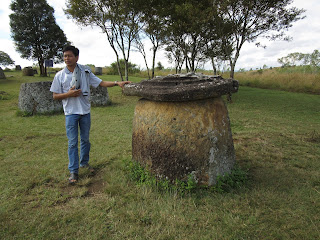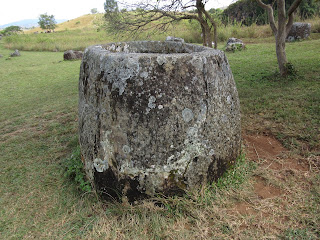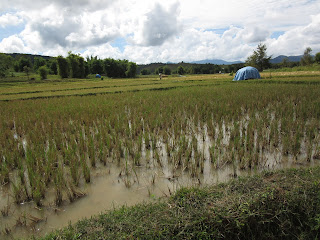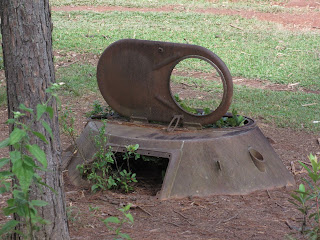Steven and I had made reservations the night before at a
travel agency to go on a guided day trip today with 2 young men who had also
traveled from Luang Prabang to Phonsavan to see the Plain of Jars. I was
therefore thrilled when we discovered that our guide for the day happened to be
Tay , someone I had read great reviews
about on Trip Advisor.
Huge stone jars of unknown ancient origin are
scattered over hundreds of square kilometers around Phonsavan, giving the area
the misleading name of Plain of Jars, which is one of Laos
Steven and I met up at 8:30
with Tay , the guide, the driver and our 2 companions for
the day: Vlad, who was born in Odessa , Ukraine US
with his family when he was 8. Interestingly, we had talked with him a week earlier
when the three of us were in the same mini van from Luang Prabang to Nong
Khiaw. Martin, a 20 something lawyer from Bratislava ,
Slovakia
One of several UXO Laos vehicles we saw in Phonsavan.
As we drove toward Phonsovan’s Tourist
Information Center Tay talked about
the bombs dropped by the US
on this area of Laos
from 1964-73. He mentioned that Agent Orange had been used extensively and area
wells are still so affected that water needs to be trucked in to many areas.
Photos of Bomb Scraps behind Tourist Information
Center
It was obviously very sobering to see first hand the discards of war.
Fuel tanks: One village is well known for making the
aluminum into spoons which are used in some restaurants in Phonsavan and also
sold as souvenirs in many shops.
Cluster bombs: Some are now recycled and used by locals as
oil lamps, bike spokes and ash trays.
Steven asked Tay how Laotians
generally feel about Americans considering the devastation wrought on their
country. He said he, like his countrymen, like Americans one on one but not the
government, the politicians OR the pilots who dropped the bombs.
Photos from Site 1:
Our first stop was Site 1, located 10 kms south of
the city, where we had to leave the car and take an electric vehicle closer to
the hilly slopes where 334 jars or fragments are located.
Tay said that it only became safe
2 years ago to walk here because cluster bombs, known locally as ‘bombies’,
were found and detonated here. He pointed out the stone, above, indicating the
site had been cleared by MAG or Mines Advisory Group. We were
glad to be on the lookout for those markers, let me tell you!
We had seen this tree all over Asia but never knew that when boiled, flowers from it, Tay said, are
great to treat baby rashes and also kidney stones.
Tay noticed this piece of bomb scrap on the path.
Above, walking to Site 1.
Below, our first view of the jars.
He said 85% of the jars were made from sandstone but some
were also made from granite and conglomerate. The jars around Phonsavan average about 1.5
meters in both diameter and height although some are considerably larger. The
largest weighs about 15 tons. Half made stone jars have been
discovered in a quarry 10kms away, Tay said.
Above, one of many bomb craters in the Plain of Jars. As the region was carpet-bombed during the
Vietnam War, it is miraculous that so many jars survived. Forty percent of the jars were damaged or destroyed by bombs, others by animals, nature, by people who used them for home foundations and those who looted the area prior to 2004 when the Plain of Jars became a protected area.
It is generally accepted that these were used as storage jars because of their different
shape.
Trench lines used by the Pathet Lao, i.e. communists.
Another bomb fragment.
He pointed out here the last vestiges of a trail where the ancient people are believed to have brought jars from the quarry to what is now known as Site 1.
With saturation bombing by American planes obliterating virtually every town and village, much of the population had to live for their protection in caves only emerging in 1973 when the 'secret war' or the 'war that never was' concluded. Tay didn't feel it was safe for us to enter the cave because of the huge number of bee nests above the entrance.
He however volunteered to walk in and take photos with my camera but cautioned us to stay quiet as he did so.
One of the 2 smoke holes in the cave.
Above, an estimated 2500 year old carving of a person. The same carving was also found in Borneo, Indonesia, Tay said.
Tay, our great guide for the day, said this was a grave marker on top of the jar and not a lid.
The jar obviously fills with water during the rainy season, Tay told us. There was an echo inside the jar, like a music box as he described it.
Steven with Tay and Martin at the 'Sandpaper Tree.' The leaves were also good as nail files, Tay told us. I believed him when I felt them!
Another bomb crater pockmarked the earth.
It was sobering to learn that the trail, above, from this part of Site 1 back to the parking lot only opened up a year ago, i.e. since it had been cleared of bombs. The cowbells, below, were made from recycled bomb flares, Tay pointed out.
The scenery around Site 1 was beyond spectacular, I thought.
Walking down the trail to the parking lot, we passed a new Hmong burial mound. You can just see the newly planted flowers bordering the mound.Back at the parking lot, we stopped at the Site 1 Visitors' Center for a few minutes to read the informative displays and to gain a greater understanding of the aftermath of war's toil on Laos. We read that between 1964 and 1973, the US conducted bombing missions over Laos every 8 minutes, for 24 hours a day for 9 years. All 17 Lao provinces suffer from UXO contamination but Xieng Khouang, where Phonsavan is located, was the second most bombed province. There have been in Laos 50,000 plus victims of UXO from 1964-2008 and over 20,000 casualties post war, i.e. since
1974.
A container with about 300 individual cluster bombs or 'bombies' that were designed to open up when released. Many of the bombies failed to detonate and instead were often buried up to a meter deep in the ground and therefore remain lethal to this day. They are especially dangerous when found by children as the bombies are small enough and look like toy.
The Lao People's Democratic Republic was established in 1975 when a ceasefire was signed among the Royal, Neutralists and Pathet Lao troops.At 11, we were on our way to Site 3. On the way, we passed many homes Tao described as Lowland Lao stilt houses, below.
Photos from Site 3:
To reach Site 3, we walked across the 'good bridge' above; Tay explained that there had been a bamboo bridge there previously. Below, some of the bamboo trees next to the bridge had been cut away because locals had removed the bamboo worm inside them for eating.
Walking across rice fields to Site 3 reminded us of our trek through other rice fields a few days ago en route to a waterfall!
With an altitude of 1200m, rice can only be harvested one a year in Phonsavan; yams is the other crop cultivated in the area.
Yup, up and over the ladder we went in search of more jars!
Very reassuring seeing the MAG stones indicating we were in safe territory.
Another ladder for us to climb up and over.
Finally Site 3! There are 3 sections here at Site 3 here but only 1 has been cleared from bombs. There were 150 smaller jars in this pretty woodland area, Tay said.
Tay pointed out the chisel markings in this jar.
The area beyond the fence was not cleared from bombs.
Tay joked about the Ho Chi Minh trail of termites on this stone!
We all got back to
the car after noon to go get a bite to eat but first we
stopped at the 'Russian Tank,' a fixture of all tours, it seemed, of
the Plain of Jars. Tay told us that between 1964-73, the Russian government
supplied the Viet Cong, i,e. the North Vietnamese. Below, we could see the
bullet hole on top of the tank and also where it had come out at the bottom! In
the second photo are the remains of the tank’s turret.
Above, a MAG encampment.
Photos from Site 2:
This Banyan tree holds special meaning for locals. Tay told us a fanciful story and pointed out the tree's elephant and buffalo shapes.
These jars were also located in a lovely woodland area.
Gravestone markings.
Gorgeous views of the surrounding area from Site 2.
These MAG stones marked the end of our tour of the Plain of Jars but we still had more places to explore with Tay, Vlad and Martin.
We were driven next to Muang Khoun, the region's ancient capital, which was ravaged by Chinese and Vietnamese invaders, then so heavily bombarded during the Vietnam War that by 1975 it was completely abandoned. However a handful of ancient monuments survived as ruins and the town slowly redeveloped.
Our first stop was Wat Phia Wat to see the Enduring Buddha. Sadly, only the temple’s
brick foundation and a few columns survive from when it was constructed in 1574, according to Tay. Others dispute that date and believe it was built in 1322.
Photos of Wat Phia Wat:
Since that time it’s faced numerous bouts of destruction. In the 14th C. when the Chinese invaded, the temple was largely destroyed and the Buddha statue’s arm was severed. It was soon rebuilt. In 1953, Wat Phia Wat was again destroyed by the French during the first Indochina War. After being rebuilt for a second time, the temple was once more shattered, this time by American bombing raids in 1966. The enduring Buddha statue with the now-melancholy face, thanks to its missing eye and scarred right cheek and lip, is highly revered by worshippers.
The Monks' living quarters.
The new temple was built 15 years ago,
Let us hope that the Buddha will be spared the ravages of war in the future.
Purple and the traditional orange colored marigolds at the base of Buddha.
Just minutes away from the Wat was That Foun also called That Chomsi where we drove next.
Photos of That Foun:
That Foun, built in 1576, is around 25m tall. We were able to climb right through a hole made by 19th C. Chinese Haw marauders, who tunneled in to loot the priceless Buddha relics inside.
Said goodbye to Martin, our Slovakian companion for the day, when Vlad, Steven and I asked to be dropped off at the Lao War Memorial back in Phonsavan at 4 rather than in the city itself. (Funnily enough though, we ran into him again just yesterday here in Vientiane after he had stopped to visit another Lao city!)
Photos of Lao War Memorial:
On an adjacent hill above Phonsavan, was the companion Vietnam War Memorial.
Photos of our walk back to town:
We thought of entering this wat until we saw and heard these dogs barking up a storm at us!
Marigold bush.
Since leaving the Memorial, we had been walking toward this handicraft shop with the hope they sold souvenir stone jars. Unfortunately our search was in vain and so we will have nothing but memories and photos of our day visiting the Plain of Jars.
Phonsavan's Market:
Creepy crawlies!
Posted on 11/13 from Vientiane, Laos.





















































































































































WOW, you had a full day of experiences. Lil Red
ReplyDelete